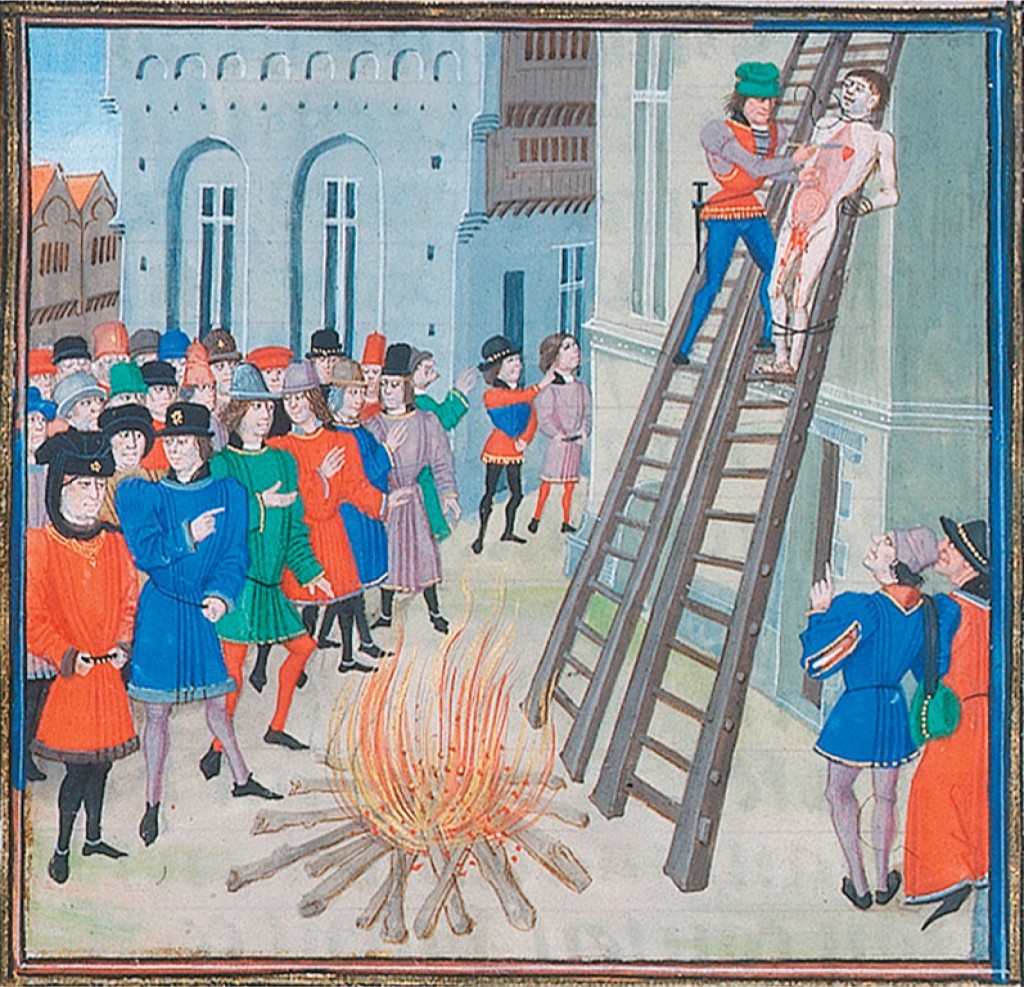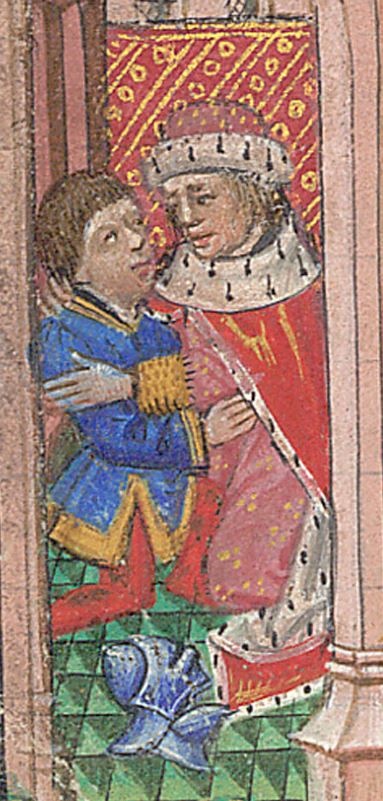In November 1326, Hugh Despenser was condemned to death for treason. Drawn to the gallows on a hurdle, he was hanged from a height of 50 feet; then, before he was completely dead, he was cut down from the gallows, eviscerated, and beheaded. His head was displayed on London Bridge, and his body was divided into quarters, which were sent for display in the populous cities of Bristol, Dover, York and Newcastle.

The fate of Hugh Despenser is intriguing not just because of its brutality (this was, after, all, a brutal age), but because of the allegedly sexual nature of his crime. Later accounts would add a new twist to the story: the late fourteenth-century chronicler Jean Froissart claimed that, in a final indignity, Despenser’s genitals were cut off, because ‘he was a heretic and a sodomite, even, it was said, with the king.’ The king in question was Edward II, and the death of Despenser came only weeks before his deposition. Within a year, Edward himself would be dead, allegedly as the result of the insertion of a red-hot poker into his anus. The symbolism of this act was not lost on later authors, who (in the words of Mark Ormrod) were keen to ‘construct the relationship of king and favourite in the sexualised imagery of a meeting between Hugh’s genitals and Edward’s anus’, thus rendering the deposed king as ‘the mere catamite of an ambitious courtier.’
The question of Edward II’s sexuality has been much pondered in recent years. His homosexuality has been both proclaimed — John Boswell called him ‘the last overtly homosexual monarch of the Middle Ages’ — and strongly denied. At a distance of seven centuries, it seems unlikely that we shall ever know the truth. What is clear is that Edward II had a number of male favourites, and that he showed them a degree of favour which was deemed unacceptable by many of his contemporaries. Chief amongst Despenser’s predecessors was Piers Gaveston, Earl of Cornwall. Like Despenser, Gaveston was showered with attention, lands and titles by the king; and like Despenser, he met a bloody end.
Although late fourteenth-century chroniclers, sixteenth-century dramatists and twentieth-century historians were keen to attribute the untimely deaths of all three men to their ‘unnatural vices’, it is not at all clear that their alleged sexuality was an important factor in determining their fates. Some contemporary chroniclers make vague references to Edward’s ‘illicit and sinful unions’, a phrase that could indicate sexual relationships with men, but could equally apply to adulterous affairs with women. Even references to sodomy are not conclusive, since medieval writers used to term in a broad sense to include almost everything outside of heterosexual intercourse in the missionary position. Edward’s contemporaries may have suspected him of sexual impropriety with other men, but this was not one of their primary concerns in the years leading up to his deposition.

In some ways, this apparent lack of concern is unsurprising, despite the medieval church’s undoubted hostility to same-sex sexuality. After all, this was an age in which elite men were expected to form intense friendships with other men. These friendships often involved practices such as kissing, hand-holding and bed-sharing which now seem inherently sexual, but were then straightforward tokens of political regard. What does come across very strongly in early fourteenth-century condemnations of Edward’s behaviour is that he showed excessive favour to some individuals, and was unnecessarily harsh to others. Gaveston and Despenser were hated because of their wealth, power and influence, which was disproportionate to their social status (both were mere knights) and had been secured at the expense of other, more deserving individuals.
In our quest to understand medieval attitudes to men such as Piers Gaveston and Hugh Despenser, it is worth comparing them with other royal favourites whose relationships with the king were unquestionably not tainted by the sin of sodomy. Their positions are arguably most comparable to that of the royal mistress, and it is worth noting that the criticism levelled at women such as Alice Perrers (mistress of Edward III) often damned them not as adulteresses, but as recipients of unwarranted amounts of wealth and influence. Even when sex was not involved, royal favourites could create a great deal of upheaval. No one suspected Henry III of sleeping with his half-siblings, but everyone could see that they were receiving a great deal of money, lands and titles at a time when all of these things were in short supply. Consequently, almost the entire English nobility launched a challenge to Henry’s rule, which dragged on for seven years and almost caused him to lose his crown.
Sarah Watkins’s recent NOTCHES article on the role of the umutoni in pre-colonial Rwanda suggested that same-sex relationships were in some ways less problematic in the nineteenth-century Great Lakes region of Africa (present-day Rwanda) than they are in many parts of the same continent today. Similarly, it seems that fourteenth-century Englishmen and women were less concerned by their ruler’s sexuality than some modern historians. Whilst the study of medieval homosexuality is clearly a valuable exercise, it is perhaps less useful to continue probing the unanswerable question of whether Piers Gaveston and Hugh Despenser were Edward II’s boyfriends, or his best friends. Ultimately their fate was determined not so much by sex, but by another combination of universal preoccupations: money and power.
 Katherine Harvey is Wellcome Trust Research Fellow at Birkbeck College, University of London, where here research focuses on the pre-Reformation English episcopate. Her first book, Episcopal Appointments in England, c. 1214- c. 1344, was published by Ashgate in January 2014, and she has also written several articles on the medieval episcopal body. Her current research project is ‘Medicine and the Bishop in England, c. 1100- c. 1500.’ She tweets from @keharvey2013
Katherine Harvey is Wellcome Trust Research Fellow at Birkbeck College, University of London, where here research focuses on the pre-Reformation English episcopate. Her first book, Episcopal Appointments in England, c. 1214- c. 1344, was published by Ashgate in January 2014, and she has also written several articles on the medieval episcopal body. Her current research project is ‘Medicine and the Bishop in England, c. 1100- c. 1500.’ She tweets from @keharvey2013

NOTCHES: (re)marks on the history of sexuality is licensed under a Creative Commons Attribution-NonCommercial-NoDerivatives 4.0 International License.
Based on a work at www.notchesblog.com.
For permission to publish any NOTCHES post in whole or in part please contact the editors at NotchesBlog@gmail.com





Thanks for a great post – I too thought of Edward II when I read Sarah Watkins’s blog on Rwanda! I completely agree with you that more work is needed to set Edward’s relationships with his favourites in the context of other royal favourites like Alice Perrers, and to foreground the compelling non-sexual reasons that those relationships were condemned – we need more posts like this! 🙂 But I’d be interested to know whether you agree completely with Mark Ormrod about sexual symbolism being the main motivation behind the invention of the “red hot spit” murder story? I don’t want to deny that aspect, or the consensus about Edward’s sexually “transgressive” behaviour that developed after his death, by any means – I’m just inclined to problematise the “penetrative murder method = symbolic punishment for sex with men” assumption, and to argue that other aspects of that murder method such as its invisible nature and its cruelty were also in the mind of the writers who invented and popularised it.
[Full disclaimer: this is my PhD topic so I’m inclined to ask overly specific questions about it… 🙂 ]
Kit
Thanks for your comment, I’m really glad that you enjoyed the post. I think I’d be inclined to broadly agree with you re. the significance of Edward’s death. I don’t think we can rule out the possibility of sexual symbolism, but on the other hand secrecy and brutality seem to me to be very important parts of the story! It was Geoffrey le Baker’s chronicle that made the poker a standard part of the narrative of Edward’s death, and cruelty is certainly a key feature of his narrative- if I remember rightly he says that Edward was kept in a cell above the rotting corpses of animals, in an attempt to poison him, and only once this failed was the poker used.
I’m also intrigued by the parallels with the death of the Anglo-Saxon King Edmund Ironside. He probably died from the after-effects of battle, but by the 12th C. all sorts of wild stories were circulating. According to Henry of Huntingdon: ‘When the king, fearful and most formidable to his enemies, was prospering in his kingdom, he went one night to the lavatory to answer a call of nature. There the son of Ealdorman Eadric, who by his father’s plan was concealed in the pit of the privy, struck the king twice with a sharp knife in the private parts, and leaving the weapon in his bowels, fled away.’ At least in Henry’s telling of the story, there doesn’t seem to be any sexual symbolism- just a tale of brutality.
I wonder whether there could also be some connection with the lower body as the place of sin (all sin, not just sexual sin), and the scatological obsessions of certain medieval writers. Martha Bayless’ book The Devil in the Latrine is excellent on this if you haven’t read it.
Thanks for your reply – it’s great to hear back! 🙂 I’ve been thinking a lot about the parallels with the Edmund Ironside story too (*shameless plug* wrote a blog on it a few months back) – I definitely agree with you that the “toilet murder” story doesn’t seem intended to be sexually symbolic. It’s interesting that the earliest text to tell the “poker” story for Edward II’s death (which I think is the Anglo-Norman “long continuation” of the Brut? – though this probably isn’t the place to start debating the dating of that text versus le Baker’s Chronicon, at risk of boring the other readers stiff!) has a different (equally bizarre) version of Edmund Ironside’s death, where he’s killed by a mechanical model of an archer. Obviously that doesn’t rule out the possibility of the Ironside story influencing the Edward story, since the Brut writer probably read Huntingdon’s version even if they didn’t use it – but it’s interesting to think about the reasons behind those decisions. In any case, as you say, le Baker’s text has a far more sympathetic narrative of Edward’s imprisonment and murder than the Brut, which stresses the angle of brutality – and that became really popular with early modern authors as they tried to fit the story of Edward’s life and deposition into a “de casibus” format.
Thanks also for recommending the Bayless book – haven’t read it, but will check it out! 🙂
Pingback: Beyond penetration: rethinking the murder of Edward II | NOTCHES